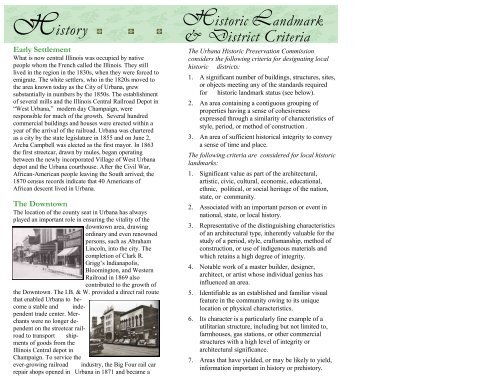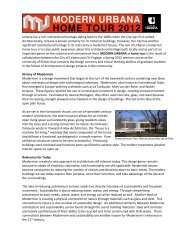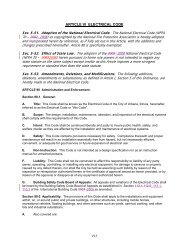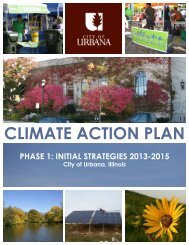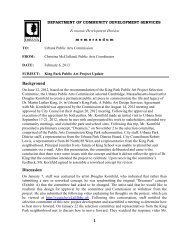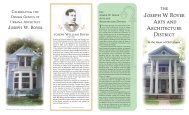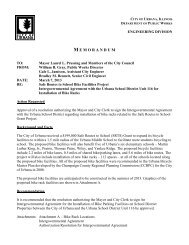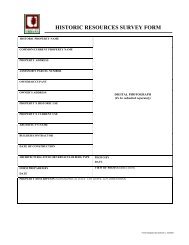Historic Urbana - A Self-guided Walking Tour - City of Urbana
Historic Urbana - A Self-guided Walking Tour - City of Urbana
Historic Urbana - A Self-guided Walking Tour - City of Urbana
You also want an ePaper? Increase the reach of your titles
YUMPU automatically turns print PDFs into web optimized ePapers that Google loves.
L LandmLandmark<br />
History<br />
Early Settlement<br />
What is now central Illinois was occupied by native<br />
people whom the French called the Illinois. They still<br />
lived in the region in the 1830s, when they were forced to<br />
emigrate. The white settlers, who in the 1820s moved to<br />
the area known today as the <strong>City</strong> <strong>of</strong> <strong>Urbana</strong>, grew<br />
substantially in numbers by the 1850s. The establishment<br />
<strong>of</strong> several mills and the Illinois Central Railroad Depot in<br />
“West <strong>Urbana</strong>,” modern day Champaign, were<br />
responsible for much <strong>of</strong> the growth. Several hundred<br />
commercial buildings and houses were erected within a<br />
year <strong>of</strong> the arrival <strong>of</strong> the railroad. <strong>Urbana</strong> was chartered<br />
as a city by the state legislature in 1855 and on June 2,<br />
Archa Campbell was elected as the first mayor. In 1863<br />
the first streetcar, drawn by mules, began operating<br />
between the newly incorporated Village <strong>of</strong> West <strong>Urbana</strong><br />
depot and the <strong>Urbana</strong> courthouse. After the Civil War,<br />
African-American people leaving the South arrived; the<br />
1870 census records indicate that 40 Americans <strong>of</strong><br />
African descent lived in <strong>Urbana</strong>.<br />
The Downtown<br />
The location <strong>of</strong> the county seat in <strong>Urbana</strong> has always<br />
played an important role in ensuring the vitality <strong>of</strong> the<br />
downtown area, drawing<br />
ordinary and even renowned<br />
persons, such as Abraham<br />
Lincoln, into the city. The<br />
completion <strong>of</strong> Clark R.<br />
Grigg’s Indianapolis,<br />
Bloomington, and Western<br />
Railroad in 1869 also<br />
contributed to the growth <strong>of</strong><br />
the Downtown. The I.B. & W. provided a direct rail route<br />
that enabled <strong>Urbana</strong> to become<br />
a stable and independent<br />
trade center. Merchants<br />
were no longer dependent<br />
on the streetcar railroad<br />
to transport shipments<br />
<strong>of</strong> goods from the<br />
Illinois Central depot in<br />
Champaign. To service the<br />
ever-growing railroad industry, the Big Four rail car<br />
repair shops opened in <strong>Urbana</strong> in 1871 and became a<br />
<strong>Historic</strong><br />
& District Criteria<br />
The <strong>Urbana</strong> <strong>Historic</strong> Preservation Commission<br />
considers the following criteria for designating local<br />
historic districts:<br />
1. A significant number <strong>of</strong> buildings, structures, sites,<br />
or objects meeting any <strong>of</strong> the standards required<br />
for historic landmark status (see below).<br />
2. An area containing a contiguous grouping <strong>of</strong><br />
properties having a sense <strong>of</strong> cohesiveness<br />
expressed through a similarity <strong>of</strong> characteristics <strong>of</strong><br />
style, period, or method <strong>of</strong> construction .<br />
3. An area <strong>of</strong> sufficient historical integrity to convey<br />
a sense <strong>of</strong> time and place.<br />
The following criteria are considered for local historic<br />
landmarks:<br />
1. Significant value as part <strong>of</strong> the architectural,<br />
artistic, civic, cultural, economic, educational,<br />
ethnic, political, or social heritage <strong>of</strong> the nation,<br />
state, or community.<br />
2. Associated with an important person or event in<br />
national, state, or local history.<br />
3. Representative <strong>of</strong> the distinguishing characteristics<br />
<strong>of</strong> an architectural type, inherently valuable for the<br />
study <strong>of</strong> a period, style, craftsmanship, method <strong>of</strong><br />
construction, or use <strong>of</strong> indigenous materials and<br />
which retains a high degree <strong>of</strong> integrity.<br />
4. Notable work <strong>of</strong> a master builder, designer,<br />
architect, or artist whose individual genius has<br />
influenced an area.<br />
5. Identifiable as an established and familiar visual<br />
feature in the community owing to its unique<br />
location or physical characteristics.<br />
6. Its character is a particularly fine example <strong>of</strong> a<br />
utilitarian structure, including but not limited to,<br />
farmhouses, gas stations, or other commercial<br />
structures with a high level <strong>of</strong> integrity or<br />
architectural significance.<br />
7. Areas that have yielded, or may be likely to yield,<br />
information important in history or prehistory.


